Loose Regulations Allow Coal Ash To Threaten River
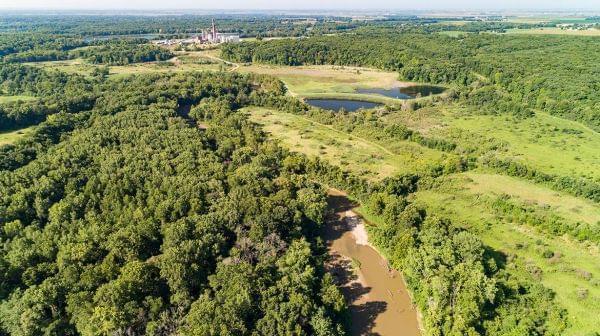
Since 1955 the Vermilion Power Plant has been storing toxic coal ash in three ponds next to the Middle Fork Vermilion River near Oakwood, Illinois. The river runs through Kickapoo State Park, which is visited by more than a million people each year. Darrell Hoemann/The Midwest Center for Investigative Reporting
Each year thousands of families boat down the Middle Fork branch of the Illinois Vermilion River below an embankment that holds back 3.3 million cubic yards of toxic coal ash sludge stored in three large ponds.
Some of the boaters might spot a line of discolored seepage in the riverbank where the force of the river is undermining the ash ponds above.
The seepage tests positive for toxic chemicals and heavy metals associated with coal combustion waste, according to environmentalists who ran the tests. When the river is low the contaminants collect in multicolored pools, evidence of groundwater flowing through the ash ponds into the river.
“Canoeing the river we see this seepage, and you just - common sense - say ‘well that can't be good,’ ” said Mike Camp, a local resident who has lived near the Middle Fork for the past 60 years. “It's not normal clear water. So I assumed it was some kind of a toxin.”

Long-time Oakwood residents Kristin and Mike Camp have become local activists to protect the Middle Fork River from coal ash pollution from the Vermilion Power Station. "Their own tests show that they're polluting the groundwater with toxic chemicals," Kristin said. "It's absolutely seeping through the coal ash pits into the river."
Kristin Camp, who often paddles on the river with her husband, added "We would see all the colors and I remember commenting to Mike the first time we saw them, you know, look at that. We didn't touch it. We knew something wasn't right.”
The coal ash ponds at the closed Vermilion Power Station sit within the flood plain of the Middle Fork, which is Illinois’ only federally designated National Scenic River. Groundwater flows through the ponds into the stream.
The site has been cited twice by the Illinois Environmental Protection Agency for serious violations of the Clean Water Act. Environmentalists and community members fear that the seepage will increase if proper measures aren’t taken to increase containment or excavate the ash and move it.
“There's been a groundwater violation notice at the Vermilion site since 2012,” said Andrew Rehn, a water resources engineer with the Prairie Rivers Network, the nonprofit environmental group that has tested the seeps.
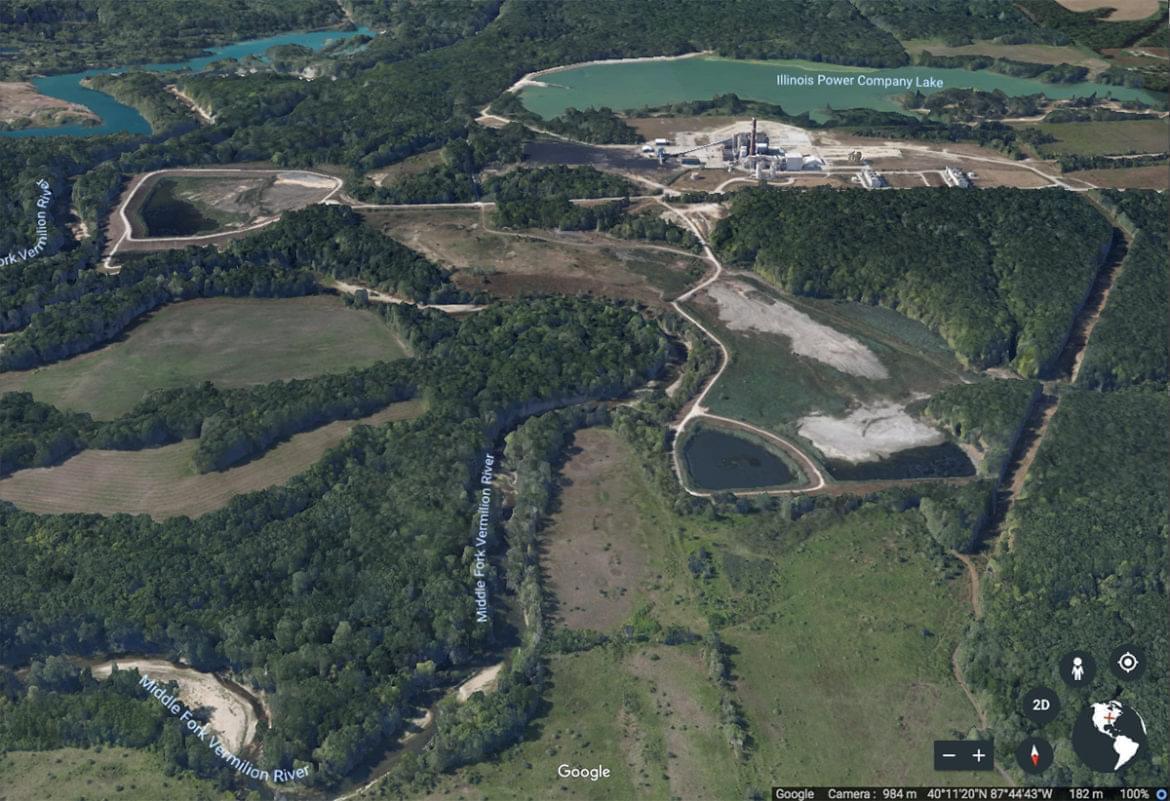
A view of the Vermilion Power Station, the coal ash ponds, and the Middle Fork River as seen by satellite via Google Earth
Local residents and officials as well as regional and national environmental groups also worry that the containment dams could eventually collapse if the site is not properly monitored. The collapse would allow up to 600 million gallons of toxic ash to pour into the river in what would be a disastrous environmental event.
Such a containment failure could overwhelm the river for many miles downstream. The coal combustion waste would flow from the Middle Fork to the Salt Fork, then into the Vermilion River and through downtown Danville.
“Obviously it would be an environmental catastrophe which is something that we want to avoid at all costs”, said Mike Marron, former chairman of the Vermilion County Board. “Beyond the environmental part it would be a huge economic and financial catastrophe.”
Such collapses have happened twice in the last decade in the U.S - in Tennessee and North Carolina.
Exacerbating all these issues is a lack of federal and state regulations that ensure the community has little say about the unsafe storage of the coal ash.
Coal plant closed in 2011
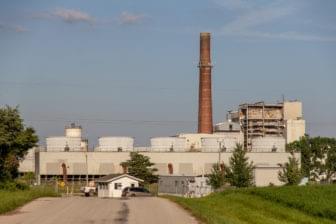
The Vermilion Power Station operated from 1955 to 2001, when it was retired by Dynegy Midwest Generation.
Illinois Power opened the Vermilion Power Station in 1955. Dynegy bought Illinois Power in 2000, and operated the plant until it was retired in 2011.
It was Dynegy’s own groundwater tests that show toxins associated with coal ash exceeding allowed contamination standards.
Vistra Energy Corp., which merged with Dynegy in April, declined to answer questions for this story, but issued a written statement denying its coal ash ponds impoundments are polluting the river.
“Rest assured: While Vistra inherited this site, as the new owner Vistra is committed to implementing an effective solution,” said the statement. “Vistra is proud of its environmental record and strong record of exemplary environmental compliance while meeting or exceeding its obligations.”
The Illinois Environmental Protection Agency issued the first groundwater violation notice to Dynegy in 2012, the year after the plan closed.
Unlike most of the other 83 coal ash sites in Illinois, the Vermilion site is not covered by federal regulations on coal ash, but it does fall under the Clean Water Act.
Meanwhile, on May 30, Prairie Rivers filed a lawsuit against Dynegy, claiming pollution from the Dynegy coal ash ponds violates the Clean Water Act.
“What we're seeing if you take a canoe down the Middle Fork is that this coal ash is seeping through the riverbank and creating a couple hundred feet of orange purple oily sheen stained riverbank where coal ash pollutants are entering the Middle Fork River,” Rehn said.
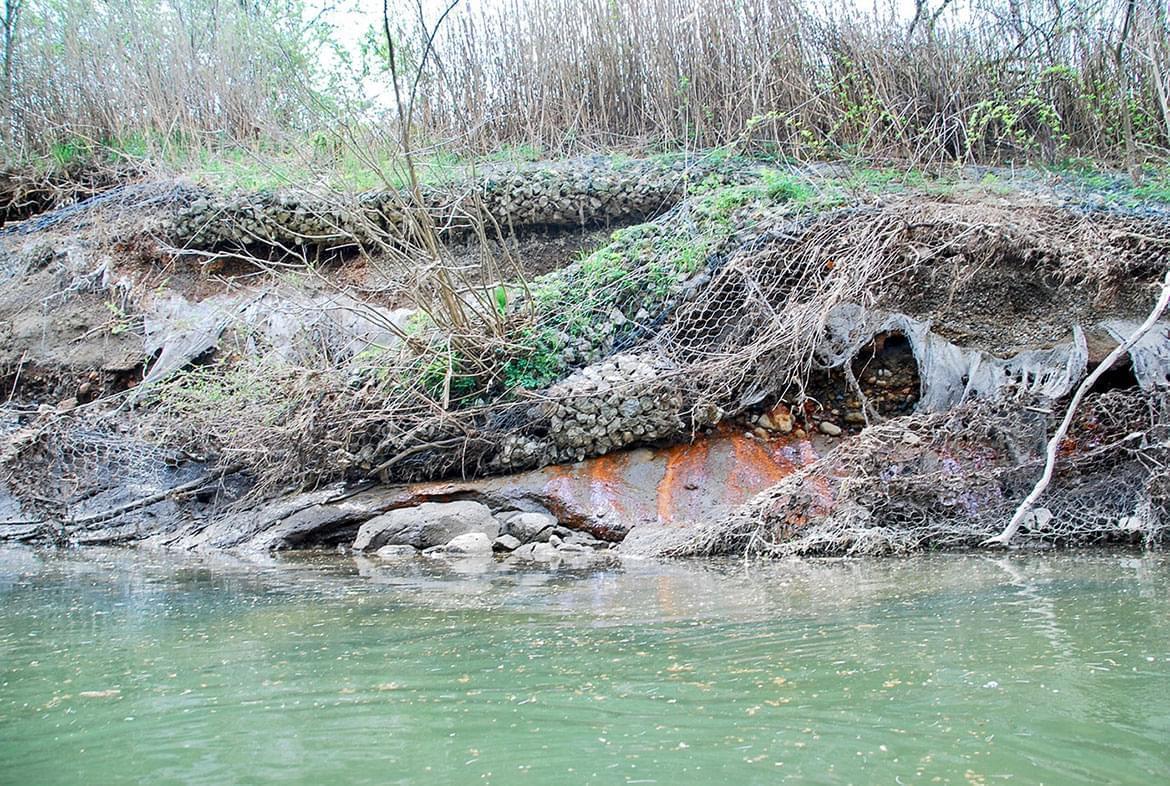
Multicolored seepage can be seen on the bank of the Middle Fork under the coal ash ponds at the Vermilion Power Station. Structures installed by Dynegy, meant to prevent erosion, have been overwhelmed by the force of the river.
On June 20 the Illinois EPA issued a second violation notice to the company for alleged pollution of surface water in the Middle Fork.
Coal ash 40 feet deep at the Vermilion site
The Vermilion Power Station coal ash ponds are 40 feet deep, extend into the ground water table, and sit within a few yards of the Middle Fork. They store more than 600 million gallons of toxic coal ash. Parts of the ponds actually have grass growing on soil dumped on the ponds to cover them.
The site has three ponds: the North Ash Pond, the Old East Ash Pond and the New East Ash Pond.
Only the New East pond is lined at the bottom to limit leaching into groundwater.
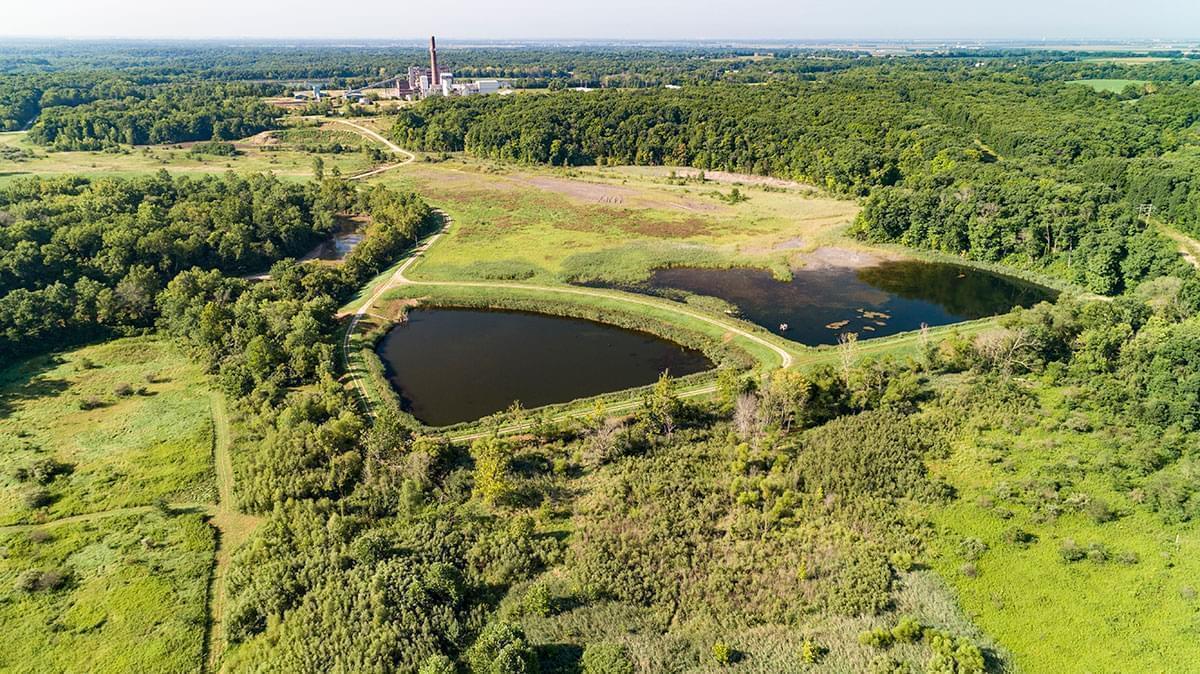
The coal ash ponds at the Vermilion Power Plant are located in the floodplain of the Middle Fork, and sit within feet of the riverbank. They are 40 feet deep and hold some 3.3 million cubic yards, or about 600 million gallons, of coal combustion waste.
No Illinois law requires Dynegy to remove its coal combustion waste from the banks of the Middle Fork River. The federal Coal Ash Rule, issued by the U.S. EPA in 2015, does not apply to retired coal plants like the Vermilion Power Station.
The lack of coal ash standards at both state and federal levels allows pollution and potential disaster at inactive sites like the Vermilion Power Station.
And in July, the EPA tried to roll back federal rules for active coal ash sites – an attempt that is currently blocked by a U.S. Court of Appeals.
Contamination and spills calling attention to coal ash
Coal ash is the combustion waste left after burning coal, and it’s one of the largest industrial solid waste streams worldwide. U.S. coal plants produced 107 million tons of it in 2016 alone. The waste contains a stew of toxic chemicals and heavy metals including arsenic, lead, mercury, selenium, aluminum, boron, chlorine, cobalt, manganese, thallium and zinc.
Toxins in coal ash can cause cancer, heart damage, lung disease, cognitive impairment, reproductive failure, kidney disease, gastrointestinal illness, birth defects and impaired bone growth in children.
There are some 992 coal ash landfills and water-filled impoundments at 414 coal-fired power plants across the U.S. Most are located next to lakes and rivers.
Source: U.S. Environmental Protection Agency data from Freedom of Information Act request (FOIA) by the Environmental Integrity Project and Earthjustice, 2012
Groundwater flowing through the impoundments can carry contaminants into public water sources.
Groundwater samples from 3,900 monitoring wells at 155 coal ash sites across the U.S. show that 76 percent of the wells are contaminated above safe levels.
Illinois has 24 active and retired coal power plants and a total of 83 pond sites, known as impoundments. Fewer than one-third are lined to limit contamination of groundwater.

Andrew Rehn is a water resources engineer with the Prairie Rivers Network.
Andrew Rehn of Prairie Rivers said the group recently reviewed groundwater reports from 18 active Illinois coal plants.
“Fifteen out of 18 had levels of contamination that were above drinking water or Illinois groundwater standards,” he said. “The only question is how much is that groundwater contamination coming up into surface water.”
Several large coal ash spills have recently brought national attention to the dangers of coal ash containment failures.
In 2008 a massive spill at a Tennessee Valley Authority coal plant released more than 5.4 million cubic yards of coal ash into the Emory and Clinch rivers near Kingston, Tennessee.
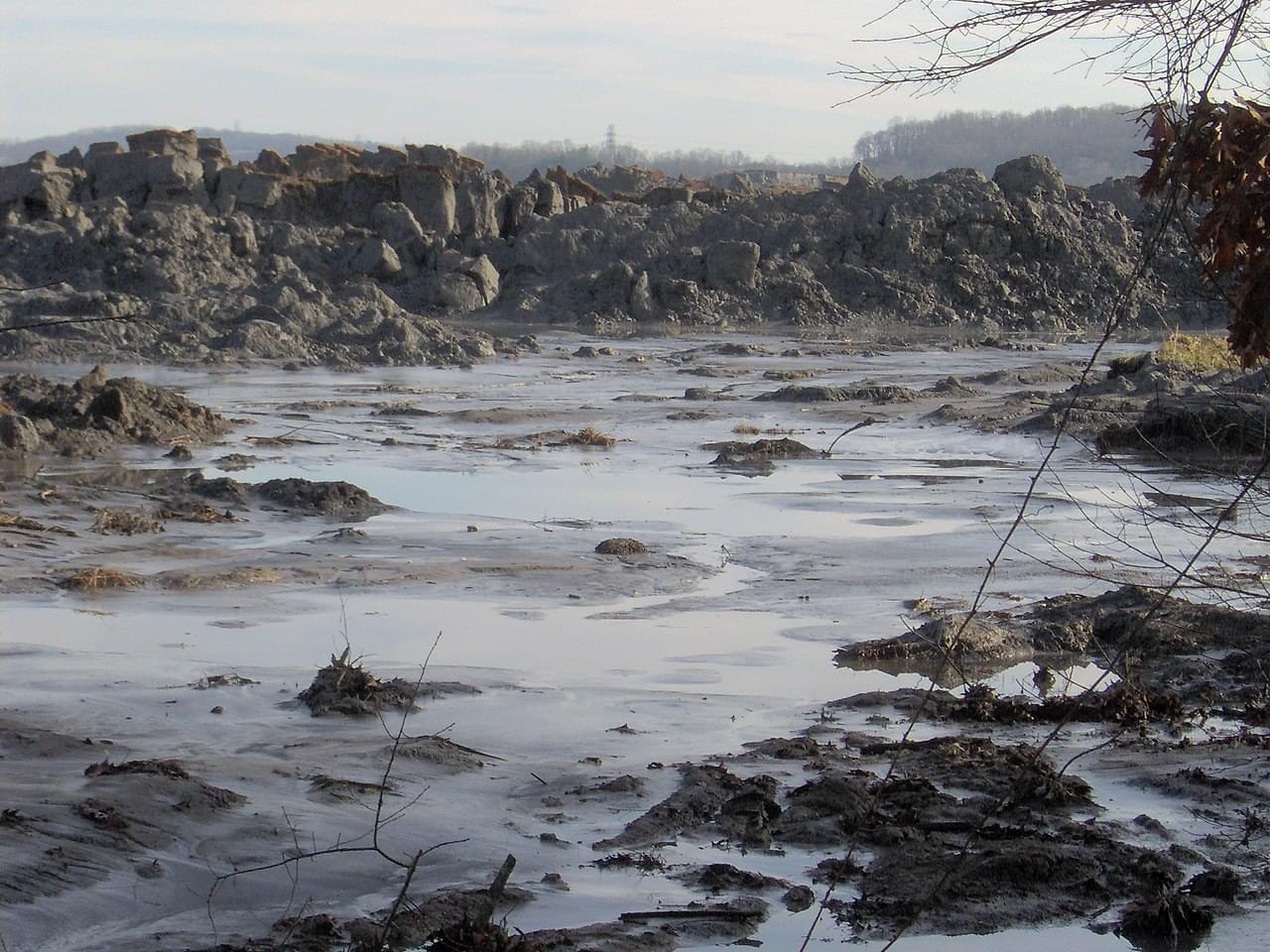
A view of the TVA Kingston Fossil Plant coal ash spill, 1 mile from the retention pond that spilled into the Emory River. The pile of ash in the photo is 20-25 feet high, and stretches for two miles.
Another spill in 2014 at a North Carolina Duke Energy plant dumped 39,000 tons of coal ash and 27 million gallons of ash wastewater into the Dan River. Duke was found guilty of environmental crimes, and the cleanup is costing an estimated $5 billion.
Vermilion ash ponds not covered by old and new coal ash regulations
The 2015 federal Coal Ash Rule established engineering standards for coal ash ponds, ad required groundwater monitoring, public reporting of contamination, and closure of ponds that pollute beyond allowed levels.
But the federal rule doesn’t apply to the Vermilion Power Station.
“Vermilion was exempted from the 2015 EPA coal ash rule because it's a so-called legacy site where there was not an active power plant in place as of the effective date of the rule,” said Thomas Cmar, an attorney from Earthjustice who is representing Prairie Rivers in its lawsuit against Vistra/Dynegy.
Illinois started making its own rules for coal ash disposal in 2010, after the Illinois EPA found groundwater contamination at sites throughout the state. A state coal ash rule was drafted in 2014, but approval remains pending before the Illinois Pollution Control Board.
On July 13 the U.S. EPA rolled back many requirements of the federal coal ash rule for plants still burning coal. The new rule relaxes standards for groundwater monitoring and contamination and delays the closure deadline for polluting sites.
A U.S. Court of Appeals has since ruled that the 2015 rule doesn’t go far enough in protecting human health and the environment, and ordered the EPA to revise the rule.
Regardless of what happens with the coal ash rule, the Illinois EPA says contamination from the impoundments may violate the Illinois Environmental Protection Act and Illinois Pollution Control Board regulations. The Prairie Rivers lawsuit claims the seeps are illegal under the Clean Water Act as an instance of “point source pollution.”
Sanjay Sofat, Chief of the Illinois EPA Bureau of Water, says his agency is concerned about the seeps.
“We have sent a violation notice to the company in June of 2018 alleging violations of the Clean Water Act and the Pollution Control Board regulations,” he said. “And you may also know that there's a citizen's suit filed in the federal court and we'll be monitoring that very closely.”
Discharging without a permit
Any “point source” of pollution – defined as industrial, municipal, or agricultural waste released into the environment from a single identifiable source – requires a permit under a part of the Clean Water Act called the National Pollution Discharge Elimination System (NPDES). Dynegy’s NPDES permit expired in 2008 but has been “administratively continued” by the Illinois EPA.
"The permit for the closed facility has been on hold to allow coordination of efforts to address bank stabilization and final closure of the ash ponds," replied the Illinois EPA replied via email on July 26, 2018, when asked about Dynegy's permit. "In the meantime, the company is still obligated to comply with the permit conditions established in Permit No. IL 0004057."
But the non-profit environmental group Prairie Rivers claims that Dynegy isn’t complying with the permit conditions.
“They are prohibited from dumping pollution into the Middle Fork except in very specific places and very specific amounts,” Cmar said. “Their permit does not allow them to have their coal ash ponds be discharging through these seeps into the river.”
Vistra Energy declined multiple requests for an interview to answer questions about the coal ash ponds at its Vermilion Power Station. In a written statement, the company insisted the groundwater seeps aren’t impacting the Middle Fork.
“Some have alleged that the river is being negatively impacted by material from the surface impoundments, but the most recent Illinois Integrated Water Quality Report, issued in 2016, tells a different story,” the company wrote. “That report confirms that the Middle Fork supports aquatic life.”
Pond closure proposal due in October
Vistra is preparing to permanently close its three Vermilion coal ash impoundments, either by excavating and removing the coal ash, or capping the ponds and leaving the ash in place. The company plans to submit a closure proposal to the Illinois EPA in October, including its latest groundwater testing and hydrological studies of the site.
Several other agencies will also review the proposal: the Illinois Department of Natural Resources, the U.S. Army Corps of Engineers and the National Park Service.
“Each agency has their jurisdiction and own requirements,” Sanjay Sofat said. “All of us are going to be looking at whatever the closure plan is to make sure that it meets our requirements.”
State law doesn’t require a public hearing or comment period on Vistra’s closure proposal.
But local residents, environmental groups and public officials are concerned that Vistra will propose to simply cap the ash ponds and leave them in place. That would save the company millions of dollars in the short term, but the risk to the river would remain.
“It represents a long-term liability, both an environmental liability as well as a financial liability to the taxpayers of the county,” Marron said. “We want to see a permanent resolution to the problem because ultimately it’s the taxpayers on the hook.”
Sofat said while public concerns may be a factor in the closure decision, the Illinois EPA is bound by regulations.
“We understand the concern but we will be making our decision based on what the requirements are,” he said. “However, understanding what the public’s concerns are, that’s definitely something we will be keeping in mind when we are making our decision.”
Excavating the coal ash verses “cap in place”
Dynegy paid for a 2017 engineering report by Stantec Consulting Services of Fenton, Missouri, which shows five options for closing the coal ash ponds. Two of the options would excavate the coal ash from the ponds either for disposal in a dry landfill or for recycling and reuse. Three options would cap the ponds and leave them in place.
“When they cap in place, we call that pollute in place,” said Frank Holleman, senior litigating attorney with the Southeastern Environmental Law Center, which has won lawsuits forcing coal companies to move coal ash to dry landfills.
“It'll be out of sight and out of mind. But the real risk from this coal ash is the flow of groundwater underneath the surface,” he said. “And capping in place doesn't have any effect on that. All it does is make it less visible.”
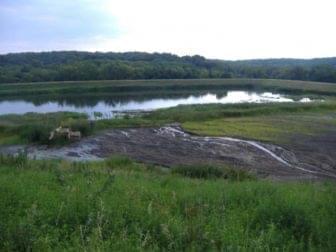
A view of the East Ash Pond at the Vermilion Power Station
If the ash ponds are capped in place, Vistra may be responsible for monitoring the groundwater for many years.
“What they can't do is pollute the groundwater,” said Abel Russ from the Environmental Integrity Project, a nonprofit watchdog organization that advocates for effective enforcement of environmental laws. “If they leave that stuff in place and it continues to leach pollutants into the groundwater, that's a violation of Illinois water pollution law.”
Sofat from the Illinois EPA says Vistra must show how its closure plan will achieve compliance with groundwater standards over many years.
“We want to see how the fate and transport of contaminant for the selected option over time will behave,” he said. “So it’s not just one time compliance, we want to see that in perpetuity.”
Compliance “in perpetuity”
Capping the ash ponds in place would also leave the site with a long-term risk: catastrophic failure of the riverbank and up to 600 million gallons of coal ash spilling into the Middle Fork.
Bruce Rhoads is a University of Illinois professor who studies the erosion processes of rivers. He said it’s impossible to predict how long riverbank armoring will hold.
“Often what happens with riverbanks is they erode from the backside. Material seeps through, water flows through the bank from the backside,” he said. “You begin to get mass failures. Large chunks of the bank begin to detach from the bank itself and they often fall forward into the river.”
Rhoads said engineering it may be possible to stabilize the riverbank for many years, so long as there is a commitment to monitor and repair any further damage the river causes. But eventually the Middle Fork will reclaim its floodplain, he said, including the location of the coal ash.
That could happen sooner due to the groundwater seeps, he said.
“If you get the right combination of subsurface geology and erosion from the river going on, and you start getting very high rates of seepage and outflow, you could get catastrophic failure,” he said. “At that point you would undermine the levee from below and the whole thing would sort of collapse downward. And the water in the pond would then spill out.”
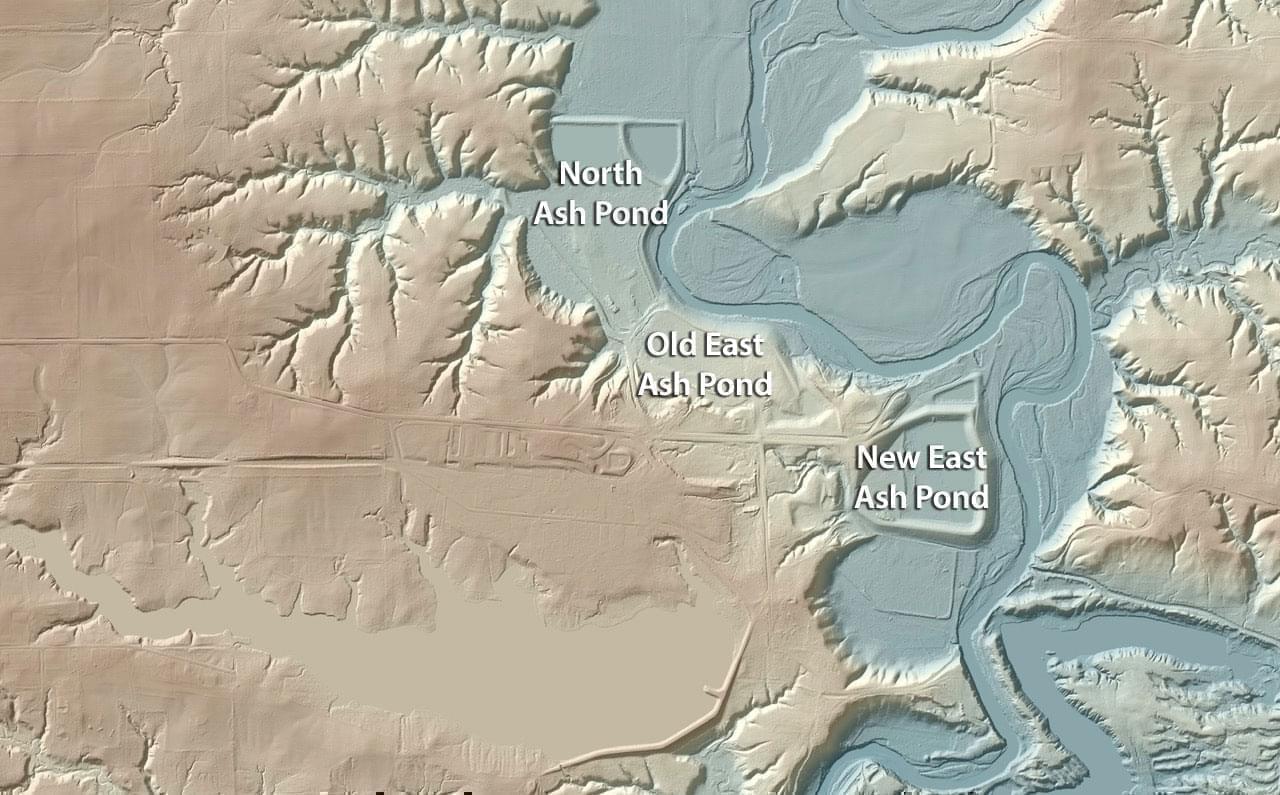
This lidar image shows the main channel and the floodplain of the Middle Fork River. The Vermilion Power Station coal ash ponds are located within the river's floodplain.
Little known of history of two ponds
Very little is known about history of the two oldest Vermilion ash ponds. Dynegy says it has no records showing if a qualified engineer supervised their design and construction. A 2013 geotechnical report by URS Corporation of St. Louis, commissioned by Dynegy, says “there is no information available to provide details of the embankment construction and it is unknown if seepage reduction and control features such as drains and filters were built into these structures.”

Rob Kanter
Rob Kanter is a Clinical Associate Professor in Environmental Science at the University of Illinois, and a Prairie Rivers Network board member. He says if the ash ponds remain, a spill on the river is inevitable.
“You think of the engineering wonders that people are capable of but the fact is the river is made up of two parts: the channel and the flood plain,” he said. “And the channel in a river that meanders, like the Middle Fork does, is only one part of that river. The floodplain is the other. The coal ash is already in the river, essentially, because it's in the floodplain.”
A precedent for Illinois ash pond closures
Dynegy is in the process of closing several of its other coal ash sites across Illinois. The coal ash ponds at the Vermilion Power Station are drawing attention now because of their visibility as a threat to Illinois’ only National Scenic River.
“The Middle Fork takes you so close to those impoundments, you're right next to it,” Prairie Rivers’ Andrew Rehn said. “We have access in a way that we don't have on any other site.”
The special status of the Middle Fork could also play a key role in the outcome.
“What's important to recognize here is the opportunity to get this one right,” Rob Kanter said. “The coal ash pits along the Middle Fork are only one site of 23 or 24 sites around the state where coal ash is situated next to water. And this is a case where there's a constituency for the river.”
But given the lack of state coal ash regulations and the recent roll back of the federal Coal Ash Rule, advocates for the Middle Fork are concerned that the Illinois EPA will accept Dynegy’s assurances that it can permanently protect the river.
“If the state accepts that a cap alone is acceptable here, I’m very worried that they will accept that solution across the state,” Rehn said. “Illinois EPA is yet to show any will to require removal at any site.”
Links
- Violation Notice Issued For Alleged Contamination At Vermilion Power Station
- Officials Call For A Public Hearing As Coal Ash Continues To Pollute The Middle Fork
- Illinois EPA Seeks Public Input On Dynegy Plan To Stabilize the Middle Fork Near Coal Ash Ponds
- Environmental Groups Call For Controls On Coal Ash Dumping
